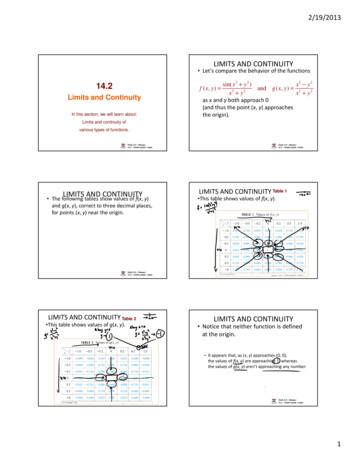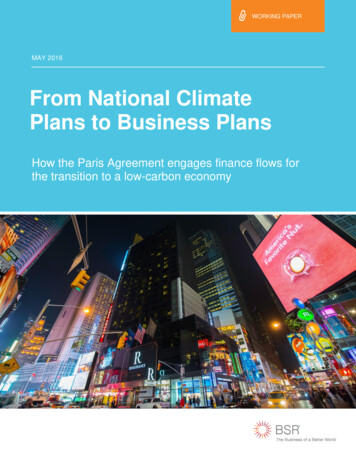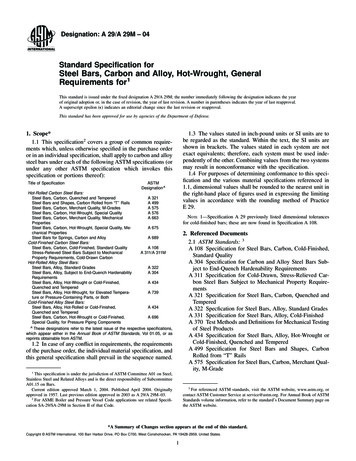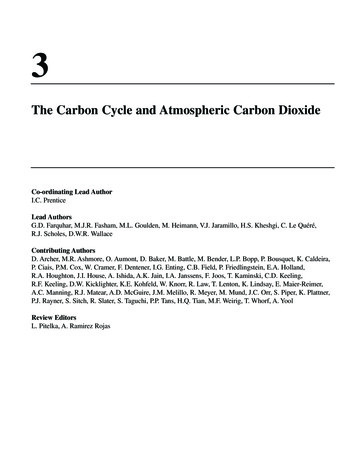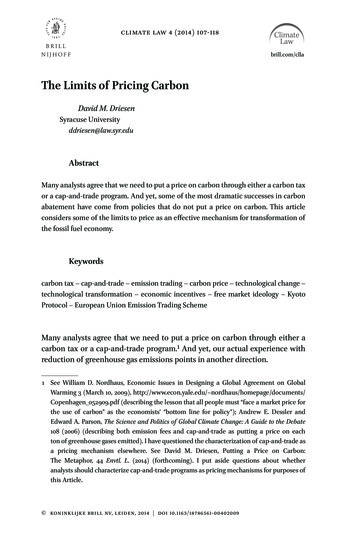
Transcription
climate law 4 (2014) 107-118brill.com/cllaThe Limits of Pricing CarbonDavid M. DriesenSyracuse Universityddriesen@law.syr.eduAbstractMany analysts agree that we need to put a price on carbon through either a carbon taxor a cap-and-trade program. And yet, some of the most dramatic successes in carbonabatement have come from policies that do not put a price on carbon. This articleconsiders some of the limits to price as an effective mechanism for transformation ofthe fossil fuel economy.Keywordscarbon tax – cap-and-trade – emission trading – carbon price – technological change –technological transformation – economic incentives – free market ideology – KyotoProtocol – European Union Emission Trading SchemeMany analysts agree that we need to put a price on carbon through either acarbon tax or a cap-and-trade program.1 And yet, our actual experience withreduction of greenhouse gas emissions points in another direction.1 See William D. Nordhaus, Economic Issues in Designing a Global Agreement on GlobalWarming 3 (March 10, 2009), http://www.econ.yale.edu/ nordhaus/homepage/documents/Copenhagen 052909.pdf (describing the lesson that all people must “face a market price forthe use of carbon” as the economists’ “bottom line for policy”); Andrew E. Dessler andEdward A. Parson, The Science and Politics of Global Climate Change: A Guide to the Debate108 (2006) (describing both emission fees and cap-and-trade as putting a price on eachton of greenhouse gases emitted). I have questioned the characterization of cap-and-trade asa pricing mechanism elsewhere. See David M. Driesen, Putting a Price on Carbon:The Metaphor, 44 Envtl. L. (2014) (forthcoming). I put aside questions about whetheranalysts should characterize cap-and-trade programs as pricing mechanisms for purposes ofthis Article. koninklijke brill nv, leiden, 2014 doi 10.1163/18786561-00402009
108DriesenWhen one looks around the world at great accomplishments in movingtoward phasing out fossil fuels, pricing policies do not always figure prominently as causal factors. France’s entire utility sector, for example, burns verylittle fossil fuel and hence produces much less greenhouse gas than comparable industrialized countries.2 This achievement comes not from any pricingpolicy but from rigid state control of a program to design and build nuclearpower plants and then to train plant operators in order to maximize safety.3Germany, of all places, has become a leading user of solar power, with almost athird of its energy coming from renewable sources.4 In the process, zero-carbon energy, including solar energy, has become much cheaper than it used tobe. How has Germany achieved this? Not by putting a price on carbon thatmakes fossil-fuel burning more expensive, but by using a positive economicincentive program called a feed-in tariff.5 This mechanism offers an abovemarket price for renewable energy, which encourages efforts to maximizerenewable-energy production and reduce its cost.6 By contrast, the world hasput environmental benefit-trading at the symbolic heart of its efforts to addressclimate disruption, but has realized only relatively modest emission reductions through trading programs.7This article considers the lessons we should learn from this juxtaposition.I do not reject the economists’ suggestion that pricing carbon is desirable, but2 Nuclear Energy Agency and Org. for Econ. Co-Operation and Dev., Nuclear Energy Data 43(2013) (showing that France gets only 8.8% of its energy from fossil fuels).3 See id. (showing that France gets 74.8% of its power production from nuclear energy); DieterHelm, Nuclear Power, Climate Change, and Energy Policy, in The Economics and Politics ofClimate Change 249 (Dieter Helm and Cameron Hepburn eds. 2009) Climate ChangeEconomics (discussing France’s ownership of the entire technology chain for nuclear energyand state training of the nuclear workforce).4 See Greg A. Hart and Dominic Marcellino, Subsidies or Free Markets to Promote Renewables,3 Renewable Energy L. and Pol’y Rev., 196, 203 (2012) (showing a 20,000 fold increase in solarenergy and 20% market share for renewables in 2011).5 Samantha Booth, Community Solar: Reviving California’s Commitment to a Bright EnergyFuture, 43 Envtl. L. Rep. (Envtl. L. Inst.) 10585, 10590–91 (2013) (noting that Germany hasbecome the first country to exceed 30 gigawatts of solar capacity because of its feed-intariff).6 Marc Ringel, Fostering the Use of Renewable Energies in the European Union: the Racebetween Feed-in Tariffs and Green Certificates, 31 Renewable Energy 1, 6 (2006) (explainingthat a feed-in tariff pays renewable energy providers an above market price for the powerthey produce).7 See Corporate Responses to eu Emissions Trading: Resistance, Innovation, or Responsibility10–11 (Jon Birger Skjaerseth and Per Ove Eikeland eds. 2013).climate law 4 (2014) 107-118
The Limits Of Pricing Carbon109argue that this juxtaposition points toward some underappreciated limits ofprice as a method to transform industrialized economies.1Climate Policy’s TaskMany analysts tend to define the policy aims of climate policy in conventionalterms: We need to reduce greenhouse gas emissions. Although this is certainlytrue, putting climate policy in those terms suggests an incrementalism inconsistent with climate science. Climate scientists remind us that we need to domore than simply reduce emissions; we need to phase out fossil fuels, reducingemissions to practically zero.8 This is necessary because most greenhousegases remain in the atmosphere for centuries, so that new emissions addirreversibly to increased cumulative greenhouse gas concentrations in theatmosphere.9 The total atmospheric concentration of greenhouse gases, not8 See Myles Allen et al., The Exit Strategy, Nature Reports Climate Change (Apr. 30, 2009), te.2009.38.html (calling for phasing out netcarbon dioxide emissions altogether and leaving substantial fossil fuel resources in theground); Michael Le Page, ipcc Digested: Just Leave the Fossil Fuels Underground, NewScientist (Oct. 1, 2013, 3:24 pm), ml#.Utmzh Qo4nK (interpreting the latest ipccdraft as a call to leave recoverable fossil fuels in the ground); James Hansen et al., TargetAtmospheric CO2: Where Should Humanity Aim, 2 The Open Atmospheric Sci. J. 228 (2008)(concluding that “remaining fossil fuel reserves should not be exploited without a plan forretrieval and disposal of resulting atmospheric CO2”); Alex Morales, Fossil Fuels Need to StayUnburned to Meet Climate Target, Bloomberg.com (Sept. 27, 2013, 9:48 am), tml (same);Veerabhadran Ramanathan and Yangyang Xu, The Copenhagen Accordfor Limiting Global Warming: Criteria, Constraints, and Available Avenues, 107 Proc. of theNat’l Acad. of Sci. of the u.s. 8055, 8057 (2010) (including the replacement of fossil fuels withrenewables as things we must do in order to halve emissions by 2050 while calling for 80%reductions by 2100); see also Henry Shue, Climate Hope: Implementing the Exit Strategy, 13Chi. J. Int’l L. 381, 389 (2013) (pointing out that many of the studies cited above may understatethe need for aggressive action because they focus only on carbon dioxide, ignoring othergreenhouse gases).9 Veerabhadran Ramanathan and Yangyang Xu, The Copenhagen Accord for limiting globalwarming: Criteria, constraints, and available avenues, 107 pnas 8055, 8056 (2010) (pointingout that the residence time for carbon dioxide is 1000 years); Thomas F. Stocker et al., ClimateChange 2013: The Physical Science Basis, Summary for Policymakers, Working GroupI Contribution to the Fifth Assessment Report of the Intergovernmental Panel onClimate Change 25 (2013) [hereinafter ipcc 2013] (noting that “a large fraction of climate”climate law 4 (2014) 107-118
110Driesenthe emissions of any one year, determines the magnitude of climate disruption.10 Any year in which we reduce, rather than zero-out, emissions involvesincreasing atmospheric concentrations above current levels and hence anexacerbation of climate disruption.11 Furthermore, climate scientists warn usthat the climate system may contain tipping points, which once crossed, maylead to catastrophic and irreversible changes. They do not know, however, howmuch warming might trigger one of the tipping points.12All of this might suggest that we should get rid of fossil fuels immediately.But that is probably impossible. The science does remind us, however, thatthe ultimate goal involves eliminating, not merely reducing, emissions.And furthermore, it suggests that we should achieve this goal as rapidlyas we can.This need to eliminate emissions implies a radical change in the basic infrastructure underlying the economy. It suggests the need for drastic energyefficiency enhancements and wholesale conversion of the remaining energysources from fossil fuels to zero-carbon alternatives.13The typical case for pricing policies rests on the observation that theyprovide an efficient means of reducing emissions. That is, they provide theleast costly way to depart from the status-quo baseline. Some commentatorshave questioned the proposition that a technique designed to foster efficientincremental change works well enough for a problem that requires wholesaletransformation of the economy.14 This question suggests that price may havesome limits as an agent of transformative change.1011121314disruption is irreversible and that even with “cessation” of emissions temperature willremain constant at elevated levels).Howard A. Latin, Climate Change Policy Failures: Why Conventional MitigationApproaches Cannot Succeed 20–21 (2012).See id. at 20–21 (pointing out that a 10% cut in emissions implies continued additions togreenhouse gas concentrations in the atmosphere).Elmar Kriegler et al., Imprecise Probability Assessment of Tipping Points in theClimate System, 106 pnas 5041, 5041 (2009) (discussing tipping points and our inability toaccurately gauge the probabilities of triggering them).See John C. Dernbach, Robert B. McKinistry, Jr. and Darin Lowder, Energy Efficiencyand Conservation: New Legal Tools and Opportunities, 25 Nat. Res. and Env’t 7, 7 (2011)(characterizing energy efficiency as “low hanging fruit”).See, e.g., Christian Azar and Bjorn A. Sanden, The Elusive Quest for Technology-NeutralPolicies, 1 Envtl. Innovation and Soc. Transitions 135, 136 (2011) (discussing the problemsof biofuels’ induced food shortages and nuclear waste disposal as reasons to doubt thedesirability of pricing mechanisms’ technological neutrality).climate law 4 (2014) 107-118
The Limits Of Pricing Carbon2111Pricing’s Modest Record So FarFor almost two decades, the global climate regime has treated environmentalbenefit-trading at its centerpiece. The Kyoto Protocol envisions no less thanthree different types of environmental benefit-trading programs, and its predecessor, the Framework Convention on Climate Change calls for experimentswith trading.15 Yet, in all this time emission-trading programs have yieldedprecious few emission reductions anywhere in the world.16This failure does not prove that pricing cannot work to produce ambitiouschange, but it does prove that political commitment to pricing tools by itselfdoes not necessarily produce significant progress in phasing out fossil fuels.After some two decades of very slow progress we need a closer look at thisfailure to realize ambitious goals.1516See David M. Driesen, Sustainable Development and Market Liberalism’s Shotgun Wedding,83 Indiana L. J. 21, 35 (2008) [hereinafter Driesen, Market Liberalism] (listing the three tradingmechanisms in the Kyoto Protocol); David M. Driesen, Free Lunch or Cheap Fix: EmissionsTrading Under the Kyoto Protocol, 26 B. C. Envtl. Aff. L. Rev. 1, 28–30 (1998) (discussing tradingunder the “joint implementation” provisions of the Framework Convention);See Blas Luis Pérez Henríquez, Environmental Commodities Markets and EmissionsTrading: Towards a Low-Carbon Future (2013) (discussing the failure of the European etsto deliver substantial emission reductions); Stefan E. Weishaar, Emissions Trading Design,87, 100–104 (2014) (discussing “over-allocation” of allowances in the European EmissionsTrading Scheme and the Japanese program’s failure to deliver reductions); Regina Betzand Misato Sato, Emissions Trading: Lesson Learnt from the 1st Phase of the eu ets andProspects for the Second Phase, 6 Climate Pol’y 351, 354–55 (2006) (finding that phase oneallocation exceeded emissions and that as of 2005 phase II allocations were only 3%below phase I); rggi, rggi 2012 Program Review: A Summary of Recommendations toAccompany Model Rule Amendments (2012), Materials /Recommendations Summary.pdf (acknowledging overallocation of cap); Nathanial Gronewold, Consultants Say rggi Beats Emission Targets byDoing Nothing, Suggest Tighter Cap, Climate Wire (November 15, 2010), www.eenews.net/climatewire /2010/11/15/archive/4 (pointing out that rggi’s cap required no action);Emissions Trading Scheme Review Panel, Doing New Zealand’s Fair Share: EmissionsTrading Scheme 2011/Final Report 17 (2011), http://www.climatechange.govt.nz (reportingthat the New Zealand ets has not produced significant domestic emission reductions);Cal Code Regs Tit 17, Div 3, Ch 1, Subch 10, Art 5 (§ 95801 et seq.) (showing that California’strading scheme only became effective in 2013); Alan Ramo, The California Offset Game:Who Wins and Who Loses, 20 Hastings W.-N.W. J. Envtl. L. and Pol’y 109, 113, 155 (2014)(pointing out that California’s cap and trade scheme is designed to deliver only 10% ofthe needed reductions and that many of these will likely be lost through a weakoffset program).climate law 4 (2014) 107-118
112DriesenThe European Union Emission Trading Scheme, the program in placethe longest, has achieved so little primarily because the cap underlyingthe program has been very modest.17 This underscores an important pointabout so-called pricing policies. They do not automatically produce progress.The government designing the program must make difficult political decisionsin order to get them to work well. In the case of a trading program, the mostimportant decision involves determining the stringency of the cap.18 In thecase of a carbon tax, the most important decision involves setting the amountof the tax. Modest caps and taxes will tend to produce very modest progress.This may seem like an obvious point, but some of the rhetoric that pricingproponents use suggests that these programs “automatically” reduce emissions.19 There is nothing automatic about them. They depend on difficultgovernment decision-making.For this reason, in spite of the abysmal empirical record so far, pricingprograms might prove capable of achieving significant changes. Governmentscan increase the stringency of the cap or the amount of a carbon tax. Indeed,the eu has increased the stringency of its cap and the Regional GreenhouseGas Initiative, a trading program for electricity utilities in the northeasternUnited States, may well follow suit.20 Sweden and Denmark have made bigstrides in reducing carbon emissions in part because of high carbon taxes.As it has taken some two decades for any country in the world to establish areasonably demanding cap, one might wonder whether there is somethingabout pricing policies that interferes with governments making hard decisionsto adopt ambitious goals. Lesley McAllister, one of the few scholars to havestudied cap-setting, argues that the problem of poor cap-setting is not uniqueto climate disruption, but has been a consistent feature of many trading programs.21 Still, the question of whether there is something inherent in pricingpolicies that leads to weak goals does not yield an unequivocal answer.One might think that pricing policies should make ambitious goals easier toset by lowering the cost of achieving them. The record suggests that the political economy of pricing is more complex than this simple observation wouldsuggest. First of all, the success of Germany and France in using relatively1718192021See Corporate Responses, supra note 7, at 11.See David M. Driesen, Capping Carbon, 40 Envtl. L. 1, 3–5 (2010) (explaining why the capis so important); Lesley K. McAllister, The Overallocation Problem in Cap-and-Trade:Moving Toward Stringency 34 Colum. J. Envtl. L. 395, 396 (2009) (pointing out thatcap-and-trade’s environmental gains depend on the cap’s level).Driesen, supra note 18, at 4 and n. 12.See Weishaar, supra note 16.See McAllister, supra note 18, at 410 (stating that “caps have not been very stringent”).climate law 4 (2014) 107-118
The Limits Of Pricing Carbon113costly methods that move toward phasing out fossil fuels suggests that somepolities can take ambitious measures without using the least costly means ofdoing so. On the other hand, the failure of the United States to adopt meaningful federal climate legislation despite bipartisan support for trading suggeststhat in some polities the prospect of cost savings does not suffice to get goodprograms enacted. Perhaps ideology and values matter more than price.This suggestion that ideology and values matter, raises some profound paradoxes for price as a mechanism. All pricing policies will fail unless citizenssupport governments enacting ambitious caps or taxes (along with otherimportant design features requiring strong government, like a willingness totax sectors using a lot of energy), yet the rhetoric supporting pricing policiestends to glorify markets at the expense of governments. In other words, theideology supporting pricing as a mechanism undermines using price effectively to achieve environmental goals.The history of the acid-rain program suggests that at least grandfatheredtrading programs can have political-economy advantages, but only in limitedcircumstances. In that case, the industry supported reasonably ambitiouslimits in order to obtain environmentalist and governmental support forthe trading mechanism. Once governments commit themselves ideologicallyto trading, as many governments now have, industry does not need to supportstrict limits to get trading, and the political-economy advantages of tradingwith respect to industry cooperation may diminish or disappear. An exampleof this comes from current debates in the United States about carbonstandards for power plants. In this case, some environmentalists support atrading mechanism because the added flexibility can facilitate setting strictergoals.22 For the same reason, industry opposes trading.23 Since the alternativeto trading might be lax limits, rather than stringent limits without the flexibility that trading offers regulated firms, they see little downside in opposingtrading.Furthermore, it has become customary to start carbon-trading programsoff very slowly. The common excuse for this has been the need for “learningby-doing”, but it has never been clear what exactly program designers expectedto learn and whether they might learn more by using a more ambitious designat the outset. One might wonder whether the rhetoric about the magic ofmarkets has persuaded governments that going slowly with ambitious limitswill not matter.2223David M. Driesen, Cap Without Trade: A Proposal for Resolving the Emissions TradingProblem Under caa § 111, 34 Envtl. L. Rep. (Entvl. Law Inst.) 10555, 10561 (2013).See id.climate law 4 (2014) 107-118
114DriesenCertainly, the values and arguments supporting pricing mechanisms haveplayed a big role in poor design. We know exactly how to design a successfulprogram. The government caps all relevant sources, imposes stringent monitoring, and only allows trades among sources with caps. That design provedsuccessful in the acid-rain program, but programs lacking caps for all sourcesof credits and including poorly monitored sources fail to achieve their goalswith astonishing regularity.24 Efficiency arguments undergird pricing mechanisms. And, in theory, allowing more sources into a trading program increasesefficiency. Yet, a good design requires exclusion of all sources not susceptible toreliable monitoring and imposition of caps. The trading programs addressingclimate disruption universally reflect rejection of sound design in favour of theideologically preferred approach of overly broad trading.Some of the slowness in realizing significant reductions from trading comesfrom difficulties governments experience in making design choices once theyhave rejected the known principles of rock-solid design in favour of theoretically efficient design. I have argued that auctioning should make programdesign simpler, but absent an embrace of auctioning, trading design becomesmore complex than traditional regulation.25 Similarly, taxation in principleshould be simple, but most pollution taxes become riddled with complexexemptions that take time to negotiate.Hence, if pricing policies can spur significant progress in phasing out fossilfuels, they can do so only if government adopts good design, including, firstand foremost, ambitious goals. Pricing mechanisms can facilitate the embraceof ambitious goals, but the ideas that come along with pricing often hindergood design.26242526See David M. Driesen, Choosing Environmental Instruments in a Transnational Context,27 Ecology L. Q. 1, 28–30–32 (2000) (explaining some of the reasons that capped programscan succeed and why program lacking comprehensive caps fail); David M. Driesen,Is Emissions Trading an Economic Incentive Program: Replacing the Command andControl/Economic Incentive Dichotomy, 55 Wash. and Lee L. Rev. 289, 314–322 (1998)[hereinafter, Driesen, Economic Incentive Programs] (contrasting the acid-rain program’ssuccess with the failure of programs not relying on caps and good monitoring of allincluded sources).See Driesen, supra note 18, at 44–50 (discussing the advantages of auctions in avoidingadministrative delays and litigation over allocation of the cap to individual sources);Driesen, Economic Incentive Programs, supra note 24, at 333 (explaining how emissionstrading complicates monitoring to verify compliance).See David M. Driesen, Neoliberal Instrument Choice, in Economic Thought and u.s. ClimateChange Policy 129, 133–141 (David M. Driesen ed., 2010) [hereinafter Economic Thought](explaining how free market ideology has led to poor design of trading programs).climate law 4 (2014) 107-118
The Limits Of Pricing Carbon3115On the Limits of Price as a Coordinating MechanismGovernment action has played a key role in creating past infrastructuretransformations. A good example comes from the creation of the us transcontinental railroad.27 Fossil fuels, too, reached industrial scale with significantsupport from government subsidies.28 Major infrastructure transformationssometimes require initial expenditures so vast that industry cannot managethem alone. When industry cannot afford the needed expenditures, putting aprice on some harm that the transformation should avoid will not solve thefunding problem.Government has often played a leading role in creating infrastructurebecause of the complexity of the coordination required to create needed infrastructure. Examples include the Manhattan Project, where the us governmentbrought together leading scientists and provided facilities to build an atomicbomb, and the space program. Markets work primarily through individualtransactions, but the coordination power of markets has limits.Some aspects of the climate problem require the kind of coordination andfunding that only government can provide. Europe has much lower transportation emissions than the United States in part because its governments havebuilt much better mass transit systems than exist in the United States.Furthermore, European governments have proven much more willing tomake land-use decisions favouring smart growth. Land-use and transportationplanning require effective governments, not primarily prices.In the climate context, pricing policies are not especially good at stimulating energy-efficiency improvements, which often provide the cheapest way ofreducing carbon emissions. Many economists have noted that energy users donot respond optimally to price in adopting energy-efficiency measures.29272829Marvin M. Brandt Revocable Trust v. us, 82 u.s.l.w. 4187, 4187 (2014) (discussing ussupport for the transcontinental railroad).See Joseph P. Tomain, Dirty Energy Policy, in Economic Thought, supra note 26, at 45,53–54 (discussing subsidies and other government support for fossil fuels).See Cameron Hepburn and Nicholas Stern, The Global Deal on Climate Change, inClimate Economics, supra note 3, at 49 (stating that because of energy efficiency investment’s insensitivity to price “carbon pricing” will do little to increase deployment ofenergy efficiency); see, e.g., Veronika Czakó, Climate Change and Sustainable EnergyAction at the City Level: The Hungarian Experience, in Opportunities and Drivers on theWay to a Low Carbon Society: Proceedings of the Summer Academy ‘Energy and theEnvironment’ 95, 99–101 (2013) (discussing subsidies funding energy efficiency improvements in Hungarian apartment buildings). Cf. Robert N. Stavins, Addressing ClimateChange with a Comprehensive us Cap-and-Trade System, in The Economics and Politicsclimate law 4 (2014) 107-118
116DriesenThe reasons for this vary. In some cases, energy users simply lack informationabout the techniques available to improve energy efficiency, a problem thatgovernments have sometimes addressed through informational programs.Another problem comes from disjunctions between the person receiving apricing signal and the person in a position to make investments that improveenergy efficiency. For example, renters paying utility bills may not be allowedto install insulation or new windows to reduce the bill. Owners may not investin energy-efficiency improvements that would pay off over the long run andtherefore be optimal for society because they do not know if they will live inthe house they own long enough to realize the cost savings. Finally, peoplewith terrific energy-efficiency opportunities may lack the funds to makecapital improvements with high up-front costs, even if energy cost-savingspay them back reasonably quickly. For that reason, governments frequentlysubsidize low-income homeowners’ energy-efficiency improvements. Pricesignals can have some influence on energy efficiency, but problems of transaction cost, imperfect information, and the distribution of capital can cause thesignal to weaken or be lost entirely.Trading programs authorizing trades outside a cap have special problems inencouraging energy efficiency. Generally, energy-efficiency improvements payfor themselves. In a trading program, the energy-efficiency improvements thatwould occur without a carbon price can generate credits justifying foregoingotherwise required emission reductions. In order to prevent this, rules requirethat polluters only purchase credits representing “additional” emission reductions. But determining additionality is complex and information-intensive, sothis restraint works very poorly. There may be good reasons for governments torely on informational programs and specific energy-efficiency standardsinstead of solely relying on taxes or trading to encourage energy-efficiencyimprovements.Another example of the limits of price involves its failure to stimulate innovations as a priority. When the California Air Resources Board (carb) tried toinsist on zero-emission vehicles, the industry fiercely resisted the requirement.carb postponed the zero-emissions mandate, but kept an overall averagepollution requirement, in effect authorizing a trading program confined to tailpipe emissions from new cars.30 This structure allowed manufacturers to avoidthe production of electric vehicles. This case illustrates an important feature30of Climate Change, supra at 198 (stating flatly that polluters will undertake “all reductions”that are less costly than the allowance price in a well-designed cap-and-trade system).Driesen, Market Liberalism, supra n. 15, at 43 (describing the lev program as a fleet-wideaveraging approach that allows trades confined to new vehicle emissions).climate law 4 (2014) 107-118
The Limits Of Pricing Carbon117of trading. It encourages the cheapest options, not the most valuable technological advances.31 In the long run, we will need zero-emission vehicles.Technological advancement frequently requires initially expensive investments that lead to technological advances gradually reducing prices over time.Thus, cars started out as luxury goods affordable only by the rich, but eventually became a much cheaper mass-produced product purchased routinely bymany people.32 Computers, at one time, were generally too expensive forindividuals; only corporations and research institutions owned them. But thecostly initial investments in computer technology eventually led to costsavings making the product more affordable for all.33Pricing favours incremental improvements over investments in the mostpromising technologies for getting to zero emissions across the economy. Thus,pricing policies may prove better in the short run than in the long run. I havediscussed this issue at length elsewhere, but the main point is simple: Shortterm efficiency and long-term technological improvement (and efficiency) donot coincide.34 This constitutes an important limit on the efficacy of price.Another limitation of pricing policy comes from risk/risk problems.Technologies reducing greenhouse emissions can produce other environmental risks. Pricing policies leave technological choices to market actors. Thisinstitutional choice may have value in bringing private
The Limits of Pricing Carbon. David M. Driesen. Syracuse University. ddriesen@law.syr.edu. Abstract. Many analysts agree that we need to put a price on carbon through either a carbon tax or a cap-and-trade program. And yet, some of the most dramatic successes in carbon . abatement have come from policies that do not put a price on carbon. This .

